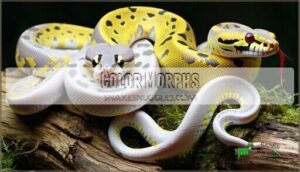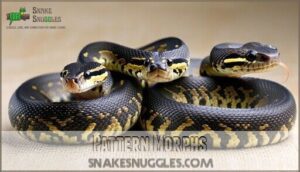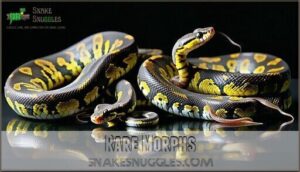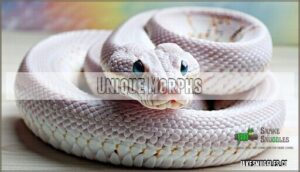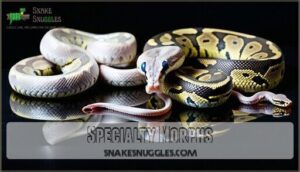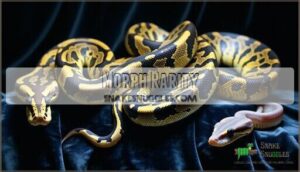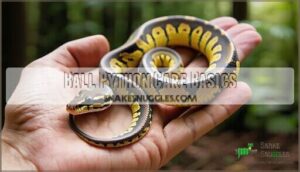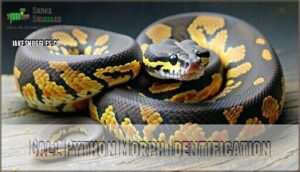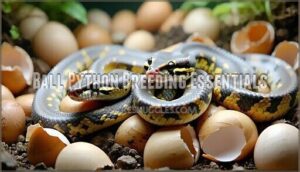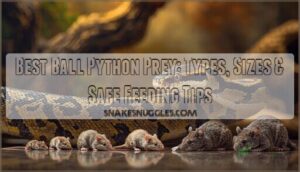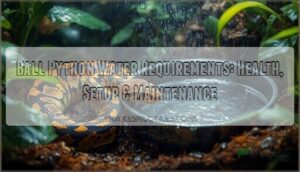This site is supported by our readers. We may earn a commission, at no cost to you, if you purchase through links.

These aren’t different species but genetic variations creating stunning combinations like the bright Banana, pristine Blue Eyed Leucistic, and striking Piebald.
Popular morphs include Albino, Spider, and Pastel varieties.
Prices range from $50 for basic morphs to thousands for rare combinations.
Ball pythons make excellent pets, requiring 40-gallon enclosures, rodent prey, and temperatures between 78-88°F.
Each morph displays distinct characteristics you can identify through color intensity, pattern distribution, and special features like blushing or head stamps that reveal fascinating genetic secrets.
Table Of Contents
- Key Takeaways
- Ball Python Morph Categories
- Ball Python Pricing Factors
- Ball Python Care Basics
- Ball Python Morph Identification
- Ball Python Breeding Essentials
- Frequently Asked Questions (FAQs)
- How many different breeds of ball pythons are there?
- Is a 75 gallon tank too big for a ball python?
- Is a ball python aggressive?
- How many breeds of ball pythons are there?
- How much does a ball python cost?
- What is the best breed of ball python?
- What is the most sought after ball python?
- Do ball pythons get aggressive?
- How long do ball pythons live?
- Are ball pythons beginner-friendly pets?
- Conclusion
Key Takeaways
- You’ll find thousands of morphs, not breeds – Ball pythons are one species with over 4,000 genetic variations creating different colors and patterns, ranging from $50 basic morphs to $15,000+ rare combinations
- Housing needs are straightforward – You’ll need a minimum 40-gallon enclosure with temperatures between 78-88°F, proper humidity levels, and rodent prey fed weekly for juveniles or every 10-14 days for adults
- Identification focuses on three key features – You can identify morphs by examining overall color intensity, specific pattern variations like stripes or web markings, and unique characteristics like blushing along the spine
- Breeding requires genetic knowledge – You’ll need to understand dominant, recessive, and co-dominant genes to predict offspring, with females requiring 1,200+ grams and males 700+ grams before breeding readiness
Ball Python Morph Categories
Ball python morphs represent genetic variations that create stunning visual differences in color and pattern combinations.
You’ll discover over 75 different morphs ranging from common pastels to rare designer combinations that can cost thousands of dollars, showcasing stunning visual differences.
Color Morphs
Color morphs transform ordinary ball pythons into spectacular displays of genetic artistry. Over 4,000 ball python morphs exist today, each showcasing unique ball python colors through fascinating snake color mutations.
Over 4,000 stunning genetic variations transform ordinary snakes into living masterpieces of color and pattern.
These ball python genetics create stunning variations through specific pigment alterations. Albino genetics eliminate melanin production, while Hypo variations reduce dark pigmentation for lighter appearances. Axanthic contrasts remove yellow pigments entirely, producing striking black-and-white snakes.
T-Albinism types affect melanin differently – T-negative creates complete absence, while T-positive allows reduced production. Caramel hues develop through specialized genetic combinations, creating lavender and cream tones. The popularity of these morphs is evident in the wide variety of types available.
Here are five popular color morphs you’ll encounter:
- Albino – Bright yellows and whites with red eyes ($300-$500)
- Hypo – Reduced black pigmentation for lighter tones
- Clown – Bold contrasting colors with unique patterns
- Caramel Albino – Lavender and cream hues with deep red eyes
- Axanthic – Striking black and white without yellow pigments ($400+)
Pattern Morphs
Pattern morphs transform ball python patterns into living artwork through genetic mutations that reshape their natural designs.
These variations create distinctive markings that make identification straightforward once you understand the key features.
Three Popular Pattern Mutations:
- Clown – Reduced patterns with wide dorsal stripes and distinctive head stamps that create bold, simplified designs
- Spider – Intricate web markings resembling delicate spider webs across the body with thin, elongated lines
- Pinstripe – Clean, thin black lines running down dark brown bodies like precise pinstripes on fabric
Each pattern combination tells its genetic story through stripe variations and unique snake patterns that breeders carefully select for ball python pattern variations.
With over 4,000 variations, breeders can explore numerous ball python morphs to create unique combinations.
Rare Morphs
Why do certain ball python morphs command astronomical prices? Morph scarcity creates this phenomenon through genetic bottlenecks and breeding challenges.
Rare genetics and limited breeding create sky-high prices for coveted morphs.
Rare morphs like Sunset cost $1,200-$2,500 due to recessive genetics discovered in 2012.
Designer morphs requiring multiple genetic variations face high cost barriers – Scaleless morphs need two gene copies, pricing above $2,000.
Acid morphs, found in 2014, demonstrate how recent discoveries drive collector demand.
Unique Morphs
How do unique morphs captivate ball python enthusiasts with their extraordinary genetic mutations?
These designer morphs combine rare genetics to create stunning visual appeal that transforms ordinary patterns into mesmerizing displays.
Here are four remarkable unique morphs:
- Blue Eyed Leucistic (BEL): Almost entirely white snakes with brilliant blue eyes, created from various morph combinations
- Bumblebee: Pastel and spider gene mix producing yellow-tan bases with intricate web-like patterns
- Highway: Gravel and Yellow Belly blend creating broken dorsal stripes with vibrant colors
- Scaleless Head: Incomplete dominant trait showing partial scale loss, leading to completely scaleless forms
Specialty Morphs
Specialty morphs represent the pinnacle of ball python morphs, showcasing extraordinary genetic mutations that create breathtaking visual displays.
These designer morphs result from complex morph combinations requiring years of dedicated breeding work.
However, some specialty morphs carry neurological issues that create breeding challenges.
Ethical breeders avoid breeding spider morphs due to potential health issues.
You’ll need to research potential health concerns before investing in these rare morphs, as their stunning appearance sometimes comes with genetic trade-offs.
Ball Python Pricing Factors
Ball python prices vary dramatically based on genetic complexity, rarity, and market demand.
Understanding these pricing factors helps you make informed decisions whether you’re buying your first snake or expanding your collection.
Morph Rarity
Stormtrooper and Lavender Albino morphs showcase how genetic bottlenecks create market scarcity.
You’ll find these rare ball pythons commanding premium prices due to breeding challenges that limit production.
Morph scarcity drives ball python price fluctuations substantially—Sunset morphs initially sold for $70,000 before becoming more accessible.
The ball python morph market rewards patience, with morph popularity shifting as availability changes.
Ethical concerns now influence breeding decisions, balancing profit with animal welfare.
Common morphs like Pastel remain affordable since they’re easier to produce consistently.
Demand Influence
Ball python prices frequently fluctuate based on social media buzz and online marketplaces activity.
Market trends show that morph popularity can double prices overnight when influencers showcase specific snakes.
Breeder influence shapes availability, while viral posts create buying frenzies.
However, market saturation inevitably follows hype, causing ball python price fluctuations.
Smart buyers monitor these patterns—future predictions suggest continued volatility in the ball python morph market.
Price Range Variations
Entry-level morph values start around $65-150, while mid-range varieties like Banana cost $200-700.
Premium ball python morph prices reach $1,200-3,500+ for rare specimens.
Market trends show auction sales closing 20-50% below retail, creating opportunities.
Adult females command double male prices due to breeding costs and investment potential.
Price stability depends on supply control and morph popularity in the ball python morph market.
Ball Python Care Basics
You’ll need proper housing, feeding schedules, and health monitoring to keep your ball python thriving for decades.
Understanding these care basics guarantees your snake stays healthy while displaying those stunning morph characteristics you’ve invested in.
Housing Requirements
Creating the perfect ball python habitat requires careful attention to enclosure size and environmental factors. Your adult python needs a minimum 4’x2’x2′ enclosure to promote natural behaviors and proper thermoregulation.
Smart substrate choices like cypress mulch or paper towels maintain ideal humidity levels between 50-60%. Avoid cedar or corncob substrates that can cause health issues.
Essential setup requirements include:
- Temperature gradients with basking spots at 95-104°F and cool zones at 72-80°F
- Secure hiding spots on both warm and cool sides for security
- Proper ventilation without drafts to prevent respiratory problems
Your ball python habitat should include climbing branches and enrichment options like artificial plants. Digital thermometers help monitor temperature control accurately. Remember, juveniles need smaller enclosures initially—upgrade as they grow to prevent stress from oversized spaces. Consider browsing the ball python enclosure options for various setups.
Feeding Guidelines
When feeding your ball python correctly, you’ll prevent most common ball python feeding problems through proper planning.
Follow these essential feeding guidelines:
- Prey Size: Choose rodents matching your snake’s thickest body section width
- Feeding Frequency: Feed juveniles weekly, adults every 10-14 days consistently
- Frozen vs. Live: Use frozen thawed prey for safety over live feeding
- Supplementation Needs: Quality rodents provide complete nutrition without supplements
- Refusal Causes: Monitor for stress, improper temperatures, or seasonal fasting patterns
Consistency creates healthy eating habits.
Source ball python food sources from reputable suppliers and monitor your snake’s weight regularly for ideal health.
Understanding ball python feeding is vital for a successful breeding program and overall snake health.
Health Considerations
Your snake’s wellbeing extends beyond feeding schedules. Watch for ball python health issues like Genetic Wobble and Spine Kinking in certain morphs. Designer Morphs carry Infertility Risks and Morph-Related Issues.
Monitor for lethargy, respiratory problems, or skin abnormalities. A healthy habitat is key, so consider products for their health.
Health Issue Warning Signs
Parasite Control
Feeding Issues
Respiratory Disease
Regular veterinary exams prevent ball python disease spread and guarantee proper ball python care.
Ball Python Morph Identification
Identifying ball python morphs requires careful observation of specific visual traits that distinguish one variety from another.
You’ll need to examine color patterns, markings, and unique characteristics like blushing to accurately determine which morph you’re looking at, considering complete concepts to make an informed decision.
Tip 1: Overall Color
Overall color reveals your ball python’s genetic blueprint.
Start with hue genetics—golden yellows indicate banana morphs, while muted creams suggest lessers.
Check color intensity next.
High saturation creates stark contrasts in champagnes, whereas low saturation produces subtle pastels.
Pigment variations directly influence these ball python colors.
Albinism types eliminate dark pigments entirely, creating bright yellows and whites.
Color combinations form your identification roadmap, making overall color assessment your first step toward accurate morph identification.
Tip 2: Pattern Recognition
When examining ball python morphs, focus on these distinctive pattern variations:
- Identifying Stripes – Look for dorsal lines running spine-length
- Recognizing Circles – Spot unique circular pattern morphs with granite-like alien heads
- Web Markings – Notice intricate spider-web designs across the body
- Keyhole Patterns – Identify flame-edged markings resembling keyholes
- Phantom Markings – Observe semi-transparent, less-defined snake pattern variations
These ball python pattern genetics create distinct visual signatures that separate similar morphs definitively.
Consulting experts can help with accurate morph identification.
Tip 3: Blushing Identification
Blushing identification reveals faded patches along your ball python’s dorsal spine that distinguish different morphs.
These softened patterns create gentle color shifts, making ball python morph identification more precise through careful pattern recognition.
Look for these key blushing indicators:
- Blushing intensity – varies from subtle washes to pronounced fading
- Blushing location – typically appears along dorsal areas or sides
- Age effects – becomes more pronounced as snakes mature
- Health indicators – clear blushing suggests proper diet influence and care
Ball Python Breeding Essentials
Understanding ball python genetics is essential for successful breeding, whether you’re planning your first pairing or expanding an established collection.
The complex interplay of dominant, recessive, and co-dominant genes determines which morphs you’ll produce and how rare those offspring will be.
Genetic Traits
Understanding ball python genetics reveals the secrets behind these stunning genetic variations.
Dominant genes express with just one copy, while recessive traits need two copies to appear visually.
Co-dominance creates unique blends when both alleles contribute equally to the phenotype.
Genetic mutations follow predictable inheritance patterns that help breeders plan successful pairings.
Heterozygous genes carry one dominant and one recessive allele, while homozygous genes contain matching pairs.
Recessive genes can hide for generations before surprising breeders with unexpected hatchlings.
Morph Combinations
Your breeding journey’s success depends on understanding how different genes interact to create stunning visual combinations.
Multiple Gene Crosses produce the most sought-after Designer Morphs through careful genetic planning. Understanding gene expression patterns is key to predicting outcomes.
Here are five proven ball python morph combinations:
- Pastel x Spider = Bumblebee (showcasing co-dominant traits)
- Mojave x Lesser = Blue-Eyed Lucy (demonstrating Super Forms)
- Albino x Piebald = requires both recessive genes present
- Enchi x Banana = creates enhanced yellow expression
- Fire x Pastel = produces vibrant orange tones.
These Designer Ball Pythons represent successful Breeding Strategies where Genetic Outcomes exceed expectations through strategic morph combinations.
Breeding Requirements
Successful ball python breeding starts with proper weight requirements. Females need at least 1,200 grams (ideally 2,000g) and 2-3 years maturity before breeding season. Males should weigh 700+ grams at 8+ months old.
Genetic compatibility testing prevents unwanted surprises in your clutch size of 3-11 eggs. Health screening catches potential issues early.
During incubation period, maintain steady 89°F for 50-55 days. Reptile breeding success depends on gradual temperature cycling from October through February, creating ideal conditions for snake breeding and healthy offspring development.
To guarantee proper egg development, consider using a quality ball python incubator.
Frequently Asked Questions (FAQs)
How many different breeds of ball pythons are there?
Like a kaleidoscope of endless possibilities, you’ll find there aren’t technically different "breeds" of ball pythons—they’re all one species with thousands of morphs.
These genetic variations create stunning color and pattern combinations through selective breeding programs, making the ball python a highly versatile and interesting species to study, with thousands of morphs.
Is a 75 gallon tank too big for a ball python?
A 75-gallon tank works perfectly for adult ball pythons.
You’ll provide plenty of space for movement while maintaining proper temperature gradients.
Adults thrive in 40-75 gallon enclosures, so you’re right on target with a 75-gallon tank.
Is a ball python aggressive?
Ball pythons aren’t aggressive by nature. You’ll find they’re actually quite docile and defensive rather than offensive. They’d rather curl into their famous ball than bite you when threatened.
How many breeds of ball pythons are there?
There isn’t one definitive number since you’re looking at morphs, not breeds.
Ball pythons have thousands of possible color and pattern variations through selective breeding, with over 4,500 documented combinations available today.
How much does a ball python cost?
You’ll pay anywhere from $20 for a normal ball python to over $15,000 for rare morphs like Pastel Zebra. Common morphs cost $50–$100, while designer varieties range $200–$1,500, with females costing more than males.
What is the best breed of ball python?
Like choosing the perfect key for your lock, there’s no single "best" ball python morph.
Your ideal choice depends on your budget, experience level, and personal preferences for colors and patterns.
What is the most sought after ball python?
You’ll find Blue-Eyed Leucistic (BEL) pythons are incredibly sought-after since they require five different morphs and up to four generations to create, making them exceptionally rare and valuable.
Do ball pythons get aggressive?
Ball pythons become briefly belligerent when threatened, but they’re naturally docile defenders.
You’ll find they prefer balling up over biting, making them beginner-friendly pets with predictable, gentle temperaments under proper care.
How long do ball pythons live?
You’ll enjoy decades with your ball python—they typically live 20-30 years in captivity with proper care. Some reach their forties, making them lifelong companions that’ll outlast many pets.
Are ball pythons beginner-friendly pets?
You’ll find ball pythons are among the most beginner-friendly snakes available.
They’re incredibly docile, rarely bite, have simple care requirements, and tolerate handling mistakes well.
Their calm temperament makes them perfect starter snakes.
Conclusion
Discovering ball python snake breeds opens a fascinating world of genetic artistry where science meets beauty.
You’ve now explored the vast spectrum of morphs, from affordable starter varieties to rare collector gems.
Understanding pricing factors, care requirements, and identification techniques empowers you to make informed decisions.
Whether you’re drawn to vibrant colors, intricate patterns, or unique combinations, these remarkable serpents offer endless fascination, a true marvel of ball python morphs.
Your journey into ball python morphs continues evolving with each new discovery, fueled by the thrill of discovering new combinations.
- https://www.worldofballpythons.com/morphs/
- https://www.oaklandzoo.org/animals/ball-royal-python
- https://newenglandreptilestore.com/pages/all-ball-python-morphs-for-sale
- https://www.reddit.com/r/ballpython/comments/b0p0dj/does_anyone_have_a_price_guide_for_the_majority/
- https://www.xyzreptiles.com/how-much-does-a-ball-python-cost/

